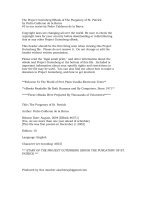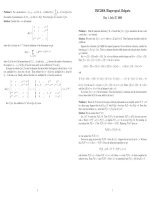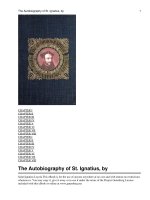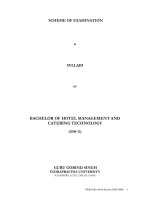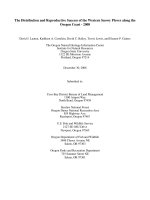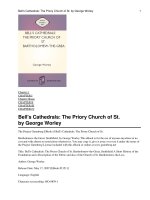- Trang chủ >>
- Khoa Học Tự Nhiên >>
- Vật lý
the christocentric cosmology of st maximus the confessor oct 2008
Bạn đang xem bản rút gọn của tài liệu. Xem và tải ngay bản đầy đủ của tài liệu tại đây (1.15 MB, 254 trang )
OXFORD EARLY CHRISTIAN STUDIES
General Editors
G C A L
THE OXFORD EARLY CHRISTIAN STUDIES series includes scholarly volumes
on the thought and history of the early Christian centuries. Covering a wide range
of Greek, Latin, and Oriental sources, the books are of interest to theologians,
ancient historians, and specialists in the classical and Jewish worlds.
Titles in the series include:
The Asketikon of St Basil the Great
Anna M. Silvas (2005)
Marius Victorinus’ Commentary on Galatians
Stephen Andrew Cooper (2005)
Asceticism and Christological Controversy in Fifth-Century Palestine
The Career of Peter the Iberian
Cornelia B. Horn (2006)
Marcellus of Ancyra and the Lost Years of the Arian Controversy 325–345
Sara Parvis (2006)
The Irrational Augustine
Catherine Conybeare (2006)
Clement of Alexandria and the Beginnings of Christian Apophaticism
Henny Fiskå Hägg (2006)
The Christology of Theodoret of Cyrus
Antiochene Christology from the Council of Ephesus (431) to the
Council of Chalcedon (451)
Paul B. Clayton, Jr. (2006)
Ethnicity and Argument in Eusebius’ Praeparatio Evangelica
Aaron P. Johnson (2006)
Union and Distinction in the Thought of St Maximus the Confessor
Melchisedec Törönen (2007)
Contextualizing Cassian
Aristocrats, Asceticism, and Reformation in Fifth-Century Gaul
Richard J. Goodrich (2007)
Ambrosiaster’s Political Theology
Sophie Lunn-Rockliffe (2007)
Coptic Christology in Practice
Incarnation and Divine Participation in Late Antique and Medieval Egypt
Stephen Davis (2008)
Possidius of Calama
A Study of the North African Episcopate in the Age of Augustine
Erica T. Hermanowicz (2008)
Justinian and the Making of the Syrian Orthodox Church
Volker L. Menze (2008)
The Christocentric
Cosmology of
St Maximus the
Confessor
TORSTEIN THEODOR TOLLEFSEN
1
3
Great Clarendon Street, Oxford 2 6
Oxford University Press is a department of the University of Oxford.
It furthers the University’s objective of excellence in research, scholarship,
and education by publishing worldwide in
Oxford New York
Auckland Cape Town Dar es Salaam Hong Kong Karachi
Kuala Lumpur Madrid Melbourne Mexico City Nairobi
New Delhi Shanghai Taipei Toronto
With offices in
Argentina Austria Brazil Chile Czech Republic France Greece
Guatemala Hungary Italy Japan Poland Portugal Singapore
South Korea Switzerland Thailand Turkey Ukraine Vietnam
Oxford is a registered trade mark of Oxford University Press
in the UK and in certain other countries
Published in the United States
by Oxford University Press Inc., New York
© Torstein Tollefsen 2008
The moral rights of the author have been asserted
Database right Oxford University Press (maker)
First published 2008
All rights reserved. No part of this publication may be reproduced,
stored in a retrieval system, or transmitted, in any form or by any means,
without the prior permission in writing of Oxford University Press,
or as expressly permitted by law, or under terms agreed with the appropriate
reprographics rights organization. Enquiries concerning reproduction
outside the scope of the above should be sent to the Rights Department,
Oxford University Press, at the address above
You must not circulate this book in any other binding or cover
and you must impose the same condition on any acquirer
British Library Cataloguing in Publication Data
Data available
Library of Congress Cataloging in Publication Data
Tollefsen, Torstein, 1953–
The Christocentric cosmology of St. Maximus the Confessor / Torstein
Theodor Tollefsen.
p. cm—(Oxford early Christian studies)
Includes bibliographical references (p. ) and index.
ISBN-13: 978-0-19-923714-2
1. Maximus, Confessor, Saint, ca. 580–662. 2. Metaphysics. 3. Cosmology. I. Title.
BR65.M416T65 2008
230
14092–dc22 2008007162
Typeset by SPI Publisher Services, Pondicherry, India
Printed in Great Britain
on acid-free paper by
Biddles Ltd., King’s Lynn, Norfolk
ISBN 978–0–19–923714–2
13579108642
For my children,
Nikolai and Juliane
This page intentionally left blank
Preface
For a start I should like to clear up a possible confusion regarding
the title of this book. In 2000 I defended my thesis The Christocentric
Cosmology of St Maximus the Confessor—a study of his metaphysical
principles (Acta humaniora 72, University of Oslo, Unipub forlag,
2000) for the degree of doctor philosophiae at the Faculty of Arts, the
University of Oslo (Norway). At the time of the defence I received a
number of copies of the printed version of the thesis, some of which
were spread abroad, in Europe and North America. When a revised
version was planned to be published by Oxford University Press, I did
not want to change the main title, because the term ‘Christocentric
cosmology’ is my own invention and it describes well the contents
of my book. However, some Maximus scholars refer to the original
thesis in books and articles published in recent years, so that the
reader should be aware that all references to Tollefsen, Christocentric
Cosmology before the publication of this book by the Oxford Early
Christian Studies, is to the thesis.
The title indicates the contents of this book. It is an investigation
into the structure of St Maximus’ cosmology or metaphysical con-
ception of the cosmos as centred in Christ. When I started my work
I had the great luck to discover that not very far away, just outside of
Stockholm (Sweden), the well-known Maximus scholar Lars Thun-
berg lived in retirement. For some years I enjoyed the cooperation
and friendship of Lars, and I even had the pleasure of being guest
in his and his wife Anne-Marie’s home in Sigtuna. At first Lars was
sceptical about the term Christocentric cosmology, but eventually he
came to appreciate it, and even commented on my idea of ‘Chris-
tocentricity’ with approval in the revised Swedish translation of his
Man and the Cosmos (St Vladimir’s Seminary Press: New York, 1985),
viz. Människan och kosmos (Artos bokförlag, 1999). I am grateful to
Lars because he introduced me to the world of Maximus scholarship,
and even though an established scholar he was a dynamic thinker,
never afraid to change his own views if he found good reasons to
do so. I should also like to thank my friends and colleagues in the
viii Preface
Medieval Seminar at the Department of Philosophy in Oslo, together
with whom I have spent a great deal of time discussing Greek Church
Fathers, St Maximus in particular. I am grateful to Fr Andrew Louth
for encouraging me to send the manuscript to Oxford University
Press, and for the generous evaluation of my original work. I also
would like to thank another Maximus scholar of the first rate, Paul
Blowers, for his kind support in this process.
I dedicate this book to my children, Juliane and Nikolai, a constant
source of joy and happiness to me.
T. T. T.
Contents
List of Abbreviations x
1. Introduction 1
2. The Divine Ideas and the Creation of the Cosmos 21
3. The Logos, the logoi, and Created Beings 64
4. The Divine Ac tivity 138
5. The Concept of Participation 190
Concluding Remarks 225
Bibliography 231
Index 239
List of Abbreviations
CAG Commentaria in Aristotelem Graeca, Berlin 1882–1909.
Capita 150 Saint Gregory Palamas: The One Hundred and Fifty Chapters,
edited and translated by R. E. Sinkewicz, Toronto 1988.
CCSG Corpus Christianorum, Series Graeca, Brepols, Turnhout.
DN Dionysius the Areopagite: De Divinis nominibus.
Enn. Plotinus, Enneads.
NPNF Select Library of the Nicene and Post-Nicene Fathers of the
Christ ian Church, orig inally published in 1886, reprinted
by Hendrickson Publishers, Peabody, Mass. 1995 (second
printing).
PG Patrologiae cursus completus, series graeca, ed. J. P. Migne, Paris
1857–66.
SCh. Sources chrétiennes, Paris 1940–.
ST Thomas Aquinas: Summa theologiae.
The Works of St Maximus
Ad Thal. Quaestiones ad Thalassium
Amb. Ambiguorum liber de variis difficilibus locis Sanctorum Dionysii
Areopagitae et Gregorii Theologii
Cap. gnost. Capita theologica et oeconomica
De char. Centuriae de charitate
LA Liber asceticus
Myst. Mystagogia
Or. Dom. Orationis Dominicae expositio
Pyr rh. Disputatio cum Pyrrho
Qu. dub. Quaestiones et dubia
Th. pol. Opuscula theologica et polemica
1
Introduction
The term Christocentric cosmology adequately describes the world-
view of St Maximus the Confessor (580–662). He thinks of the whole
natural cosmos as made because of a Trinitarian motif, by the Son
of God, with Him as the centre of all created being, and with a view
to the establishment of communion between created and uncreated
being in Christ, the Logos.
If such is the case, one might still wonder what is the point of
writing a book on it. Maximus’ ‘system’ represents an impressive
intellectual effort. It contains a lot of ideas prepared in his prede-
cessors, but worked out by him as his philosophy (see § below).
Like the philosophy of Plato and Aristotle, Plotinus and Augustine, it
belongs, for sure, to the past. But like their philosophies it has virtues
pointing beyond the ancient world, even into the contemporary
world. Maximus’ thinking of God and creation, of creation as centred
in Christ, and of a connection between cosmology and soteriology
makes interesting sense of Tr initarian theology and of God’s love and
perfection. It also makes a strong motivation for an ecological con-
sciousness as one of the major ethical challenges confronting modern
human beings. In Maximus’ system one finds God’s remoteness from
and closeness to the created cosmos defined philosophically, but the
meaning of this remote and close God in Maximian theology is settled
in the mystery of love. If God is God, the divine must be honoured in
its majestic remoteness be yond all creatures. If God is God, according
to Maximus, God’s majestic beyond is all the more to be honoured
because in the Divinity’s perfect inner life there occurs eter nally a
motif for creative and salvific action: philanthropia, love of human
beings.
2 Introduction
All of Gods activity has one single purpose, viz. to unite the world
to Himself. Maximus asserts that the creation and ordering of the
worldisanembodiment(Kèẽẩ)oftheLogos:
1
Always and
in all Gods Logos and God wills to eect the mystery of His own
embodiment. The Logos is embodied in the world by certain logoi
that come from Him. These logoi of beings are a kind of divine Ideas
which, taken together, constitute the divine plan for the created cos-
mos. On the basis of this plan, as it is actualized in a world consisting
of intelligible and sensible beings, the foundation is laid for a cosmic
conversion (Kẩềễ)toGod.Thelogoi belong to the Logos and this
Logos/logoi-conception is, then, the backbone of Maximus world-
view.
In the following chapters I will try to develop Maximus thought in
a systematic way, analytically and synthetically. That is, I shall present
the system as it can be extracted (synthesized) from his works,
without taking into consideration any chronological development.
I shall further ask analytically what is the relevance of Maximus
principles and whether his arguments are sound within the context
they are put forward.
After this introductory chapter (Chapter 1) I shall make some com-
ments on the philosophical doctr ine of exemplarism and Maximus
doctrine of creation (Chapter 2). Then follows his theory of the Logos
and the logoi as the central theological (Trinitarian) principles of cre-
ated being (Chapter 3). With the metaphysical structure of the world
in mind we move to Maximus thinking of the divine energeia (energy
or activity) at work in the soteriolog ical scheme of things (Chapter 4).
The last chapter is devoted to the concept of participation which
plays an important role in Maximus total conception of the world
in relation to God (Chapter 5).
The topic of participation is quite obscure, and I cannot think of
any modern patristic scholar who has tried to dene it in a more
precise philosophical way. However, I believe I have found a key to
the ancient understanding of the concept with the aid of a paper by
Dominic OMeara from 1980.
1
Amb. 7, PG 91: 1084cd: òễẻẩãẩ aề Id ãd Kè Aẩ ễF ằễF áễ ãd ằe
B ãPễF Kèẽã KèềEậãẩ e ẽềẩễè.
Introduction 3
In the Conclusion I focus on two modern problems for which
this Maximian cosmology is relevant: the human rights issue and the
environmental issue. But although this book ends by highlighting the
relevance of this ancient Christian system for the modern world and
modern problems, what comes in between is a philosophical analysis
and treatment of a fascinating, beautiful, but difficult philosophical
and theological interpretation of created being.
I. ST MAXIMUS’ WRITINGS AND
THEIR INTERPRETATION
What can we say about the writings of this major thinker of high
sophistication and penetrating mind? What kind of condition are
they in, what kind of genres did he use and how readable are they?
In the Alexiad, Anna Comnena relates with admiration that her
mother often was seen with a book by ‘the philosopher and mar-
tyr Maximus’. One day Anna says to her mother that she herself
would never have dared to listen to a doctrine as sublime as that of
St Maximus’. His writings, Anna says, are highly contemplative and
theoretical (‹Ìı Ë¢ÒÂÙÈÍ¸Ì Ù ͷd ÌÔÂÒeÌ).
2
His teaching, obviously,
is considered difficult to understand, and with this statement the
modern interpreter can only agree. We could suspect also that the
texts are difficult to read because of the complexity of their syntax, and
to this the modern reader could bear witness as well. Philosophically
hard, syntactically tough as they are, it is worth remembering that
some of his writings are harder to read and understand than others,
as we will see below.
It often helps to solve at least some initial riddles of a text if we are
able to place it in a literary genre. When it comes to genres, however,
one has to search carefully in the literature on Maximus to find
substantial remarks.
3
This is unfortunate because the classification
of a literary work according to its form often gives a clue to how
it should be interpreted. Nevertheless, the consideration of genres
wil l only make a difference if we know something of the author and
2
Anne Comnène, Alexiade (Paris 1967), book 5, 9.3.
3
Cf. Louth (1996), 20–2; Blowers (1991), ch. 1.
4 Introduction
are able to place him within a cer tain historical setting. One could
object, of course, that this is a rather awkward view of hermeneutics.
On the other hand one should remember that the present subject
matter is Maximus’ thought and I find it reasonable to hold that the
man himself and the context of his activity are both relevant for the
interpretation of what he wrote.
What, then, do we know about him? I believe there are three
relevant pieces of information that could help us: he had a solid
education, became a monk and was engaged in the controversy over
monotheletism. As a monk, his spiritual life developed within a cer-
tain setting, and as an educated monk we would expect his writings
to reflect both a strategy to place monastic strivings within a wider
soteriological scheme and a concern for exposing unsound spir itual
doctr ines for critique. Further, we s hould expect a coherent polemic
against those he considered heretics. A first reading of the texts con-
firms initial anticipations and therefore makes it a reasonable project
to search for the soteriological scheme and for the theoretical foun-
dations of his polemics against the heretics. However, my purpose
is not to investigate Maximus’ anti-monotheletistic strategies, but
to work out his philosophical ideas. On the other hand, a major
thinker engaged in polemics of this kind, should be expected to work
out a lot of categories of general philosophical relevance, and this
he does. I am thinking of precise definitions of essence and nature,
identity and difference, different kinds of unions, the concept of
participation, etc.
In the study of ancient philosophy it is considered important to
take into account Plato’s dialogue-form and Aristotle’s treatise-form.
Andrew Louth classifies Maximus’ works in three literary genres,
which seems reasonable. First he mentiones the genre of gnostic cen-
turies, further comes the genre of question and answer, and, finally,
the commentary.
4
Evagrius, Nilus, Diadochus of Photike, and Macarius practised the
style of gnostic sentences.
5
Maximus’ Centuriae de charitate (hereafter
De char.)andCapitula gnostica (or Capita theologica et oeconomica,
hereafter Cap. gnost.) are both in the genre of ‘gnostic sentences’. Such
sentences or chapters were combined in so-called ‘centuries’, each of
4
Louth (1996), 20–1.
5
Thunberg (1985), 22.
Introduction 5
which contains 100 small texts.
6
A ‘chapter’ is in fact not a very long
section. It contains from one to just a few sentences. These chapters
were arranged according to topic, as is seen for instance in the De
char., which contains four centuries on charit y .
The genre was an established monastic style of writing before
Maximus composed his works.
7
They invite the reader to slow and
concentrated study, to some kind of ‘contemplative reading’. Only
this way would it be possible to detect the chains of meaning run-
ning through the text. In a monastic setting of Maximus’ days the
purpose of the genre would be to awaken practical understanding of
the ascetic way with its internal connection to the deep truths of the
Christian faith. Such texts are well suited for contemplative activity,
hence the practical motive which lay behind the use of this genre.
One would not gain much by reading through the text in one full
swoop. Nor will a modern interpreter gain much if he is not going to
carry the burden of contemplative reading. Rather, one has to dwell
with the text, reflect over it and discover the connection between
the chapters and centuries in a gradual uncovering of their central
idea.
The writings composed as questions and answers were for the most
part written to persons who posed different questions to Maximus.
Here two things should be noted. Firstly, these works were commen-
taries on difficult texts from the Bible (Quaestiones ad Thalassium),
from the Fathers (Ambigua)orboth(Quaestiones et dubia). Maximus
also composed plain commentaries, such as Expositio in psalmum lix,
Orationis Dominicae expositio (hereafter Or. Dom.)andMystagogia
(hereafter Myst.). The last-mentioned work is an interpretation—
rich in philosophical implications—of the Liturgy. Secondly, these
writings are, according to the genre, connected with the monas-
tic catechesis. They are mostly addressed to individuals and fol-
low the pattern of question and answer that spiritual Fathers used
when they instructed their disciples. Maximus has composed a work
which directly anwers to this catechesis, the Liber asceticus, a dialogue
between a spiritual Father and his pupil.
6
In other authors there are examples of centuries with 90 and even 150 chapters.
Louth (1996), 20, explains why for instance Evagrius uses 90 chapters.
7
Thunberg (1985), 22; Louth (1996), 20.
6 Introduction
The major works in the genre of question and answer, viz. the
Quaestiones ad Thalassium (hereafter Ad Thal.) and the Ambigua
(hereafter Amb.), are to a great extent composed as rather long and
complex expositions of major theological and philosophical interest.
The complexity concerns both the syntax and the theoretical con-
tents. The language of the centuries is often easier and more readable
than, for instance, the Ambigua.TheAmbigua requires slow study and
considerable linguistic and philosophical acuteness of its readers.
Several of Maximus’ letters and of his Opuscula theologica et polem-
ica (hereafter Th. pol.) also belong to the genre of question and
answer.
The texts taken as the point of departure for my interpretation are
partly found in Migne’s Patrologia g raeca (hereafter PG), volumes 90
and 91, partly in the Corpus Christianorum, Series Graeca (hereafter
CCSG). In CCSG the most important critical editions are published.
The series is, however, far from complete.
8
Moreover, new editions
are being published at a slow rate. It could, of course, be considered
a problem that the whole corpus has not yet appeared in a critical
edition, but as it is we have no choice but to use the PG while we
wait for something better. According to Lars Thunberg, a comparison
between the PG edition and the CCSG edition of the Ad. Thal.shows
that the PG is not inaccurate to a degree that should disturb us
unduly. This is the verdict of Andrew Louth as well, when in a review
essay from 1998 he says that (so far) the CCSG edition for the most
part ‘has provided welcome assurance of the general reliability of the
text (of Combefis and Oehler) published in Migne’s Patrologia Graeca
(90–1)’.
9
We have no choice but to work with the text of the PG, since
a full critical edition belongs to the future.
10
II. ST MAXIMUS ‘THE PHILOSOPHER’
Should we consider St Maximus a philosopher? This question in
my opinion we should answer in the affirmative. If St Augustine
is a philosopher, if Bonaventure is a philosopher, yes, if Plotinus
8
See the bibliography for the editions I have used.
9
Louth (1998), 68.
10
Thunberg has told me that he once (by letter) asked P. Sherwood about the
condition of the texts, and received the answer that to a great deg ree we can trust
the PG. I hope the future will not show that our trust was unfounded.
Introduction 7
is a philosopher, Maximus is as well. He figures in the history of
dogma as the greatest theologian of his century. He is remembered
as the monk who defended the doctrine of the two w ills of Christ
against monotheletism. This defence, however, was based on a body
of philosophical ideas developed prior to his engagement in that
controversy. Like other Christian thinkers in the early Church he was
not aware of any distinction in principle between Christian theology
and philosophy. If we draw the line backwards in history, to St Justin
Martyr, we can see how intellectual Christians could consider their
own faith to be the true philosophy. This does not mean, of course,
that Christianity, by its learned representatives, was looked upon as
one philosophical school among other schools. But if Christianity is
the true philosophy, then other philosophies would be disqualified
as adequate interpretations of reality. Furthermore, as philosophy,
Christian truth was deemed to have an intelligibility that legitimized
it before the human intellect. In the Dialogue with Trypho Justin held
that the task of philosophy is to inquire about the Divine.
11
Many
have failed, he says, to discover the true nature of philosophy. There-
fore a lot of different schools have emerged. Basically the science of
philosophy is one and the same, and it was given to men for a specific
reason. He says philosophy is precious in the sight of God, to whom
it leads us and unites us.
12
A similar view of philosophy is found
in St Gregory of Nyssa, when in T he Life of Moses he defined truth
as the sure apprehension of real being. The philosophical life is the
life in quietness (ôÛı˜fl·), which, on this view, was identical with the
monastic life.
13
Philosophy, as the contemplation of divine matters,
is not something that the Church has to borrow from ‘the Greeks’.
On the other hand, Gregory admits that Greek learning could be
useful.
14
Maximus was well aware that there existed a pagan or ‘Greek’
philosophy. But, on his view, genuine philosophy was Christian phil-
osophy. Philosophy, in this understanding of the word, is taken as
‘the love of wisdom’, this wisdom being ‘the Wisdom of God’ (ô ÛÔˆfl·
ÙÔF »ÂÔF ), which is the same as ‘the Logos of God’ (≠ À¸„ÔÚ ÙÔF
»ÂÔF), i.e. Christ.
15
In Christ, St Paul says, ‘are hidden all the treasures
11
The Dialogue with Trypho,ch.1.
12
Ibid., ch. 2.
13
De vita Moisis 2.23.
14
Ibid. 2.115.
15
Cf.1.Cor.1:24andJohn1:1ff.
8 Introduction
of wisdom and knowledge’.
16
In the De char. Maximus says: ‘The
Christian philosophizes in these three things: in the commandments,
in the dogmas and in the faith. The commandments separate the
mind from the passions, the dogmas introduces it to the knowledge
of beings, and faith introduces it to the contemplation of the Holy
Trinity.’
17
Now, this saying is to be connected with Maximus’ doc-
trine of a threefold spiritual development.
18
The terminology varies,
but the first stage is in some passages called ‘practical philosophy’,
the second is called ‘natural philosophy’, and the third ‘theological
philosophy’. We should not forget that the term philosophy has con-
notations in the direction of the monastic life, but this does not
mean that in every instance we should simply equate philosophy with
monasticicm: they may have the same reference, but not necessar ily
the same intention. To philosophize in the three things mentioned in
the citation should be the normal activ ity of one living a monastic life
or even of all Christians, as the text from De char. has it.
The Scriptures are not scientific or philosophical textbooks that
explicitly teach the details of a philosophical world-view. On the
other hand, the scriptural teaching about God and His creatures has
implications that could be worked out philosophically. Further, on
Maximus’ v iew, God has revealed Himself, not only in the letters and
syllables of the Scriptures, but in the created, natural world itself.
There are two laws, the written law and the natural law, and both
have equal honour and teach the same things. Neither is greater or
less than the other.
19
The divine revelation in Scripture and nature is
not something that is ‘written out’ in easily accessible articles. The
basics are made explicit in the traditional dogmatic teaching of the
Church, but even what this teaching implies for the details of a whole
world-view has to be searched out by a properly trained intellect. An
intellect is, according to Maximus, on its way to be properly trained
when man moves on the path of spiritual development. A properly
trained intellect is in this context the intellect of the good interpreter,
and the good interpreter is the one who in a sound way is able to
expound the different senses of the sources, i.e. the Scriptures and
nature. Perikles Joannou says that for the Byzantines, philosophy is
16
Col. 2: 3.
17
De char. 4.47, PG 90: 1057c.
18
For details see the last part of ch. 4 § .
19
Amb. 10, PG 91: 1128d.
Introduction 9
‘Lebensanschauung’. It is neither a philosophy of concepts nor know-
ledge reached with the pure reason alone, but rather an experience of
the All (‘Ganzheitserlebnis’) w ith the purpose of giving structure to
human life and achieving likeness with God.
20
Two qualifications should be made here. (i) Even though philoso-
phy for Maximus is ‘Lebensanschauung’, he does not lack interest in
theoretical concepts. Rather, he tries to work out definitions of se v-
eral important, ontological conceptions, for instance the meaning of
different kinds of unions, the meaning of essence, nature, hypostasis,
enypostaton, will, etc.
21
Some of his lists of definitions or treatments
of terms could remind one of Aristotle’s Metaphysics book 5. (ii) Even
though Maximus is not preoccupied only with the kind of knowledge
we gain with the pure ratio, he seems to think that the Christian
faith somehow is intelligible. Here we move, however, into a rather
intricate subject area, for according to Maximus the essence of God,
the triune character of the div ine being, its internal life and divine
activities, are (according to their inmost nature) beyond human com-
prehension. Whenever we talk of God, philosophically or popularly,
we may talk truly if we talk in accordance with right reason, but
our talk can never be adequate. We are constr ained to talk within
the boundaries of created being, but what we talk of (i.e. God) is
not limited by the categories of created being. There are mysteries
transcending the human mind, but transcending the capacity of the
mind does not mean that something is in itself contrary to reason, i.e.
unreasonable, but that it is beyond human capacity to reach it.
LetusreturntothequotationfromDe char. 4.47. The Christian
philosophizes in the dogmas, and the dogmas introduce the mind to
knowledge of beings, Maximus says. Even though not immediately
intelligible, I think this may be a convenient starting point to develop
some thoughts on an important philosophical subject, viz. that of
method. ‘The dogmas introduce the mind to knowledge of beings.’
Now, a twofold question emerges here: what is meant by dogmas
and how do they introduce knowledge of beings? A quotation from
Mystagogia chapter 18 may offer a glimpse into how Maximus thinks
20
Joannou (1956), 2.
21
Cf. Th. pol. 18 (PG 91: 213a–216a), 23 (PG 91: 260d–268a), and 26 (PG 91:
276a–280b).
10 Introduction
in this connection: ‘The profession by all of the div ine symbol of faith
signifies in advance the mystical thanksgiving to perdure through the
age to come for the marvellous logoi and tropoi by which we were
saved by God’s all-wise Providence on our behalf.’
22
We should note
the liturgical context: Maximus comments on the Divine Liturgy.
The profession of the Creed signifies the thanksgiving for the logoi
and tropoi ‘by which we were saved’. On Maximus’ view, that is, the
Trinitarian confession indicates the cosmological and soteriological
system that he expounds in his philosophical theology. His doctrine
of logoi and tropoi are in fact, as we shall see, an interpretation of the
Christian faith in which the system of reality is presented as a divine
device to accomplish the deification of man and nature.
Basic principles of his system, then, are found in the liturgical
insight into dogmatic truths, and from these principles he deduces
philosophical implications. The basics of his system are the credal
confession to the divine Triad and to God’s Incarnation as it is under-
stood by the Council of Chalcedon (451): the uncreated and the
created nature in Christ are united hypostatically without confusion,
without change, without division, without separation. This ‘logic’,
according to Maximus, not only regulates the primary instance of
the Incarnation of the Logos, it is also a general law for the relation
between the divine and the created sphere.
23
From these principles
a rational interpretation of being (the world and man in relation
to God) is built up by the aid of traditional logical procedures. The
interpretation is expressed in a critically revised and Christianized
philosophical vocabulary.
His philosophical terminology, even though largely identical with
that of the philosophical schools, is filled with a new, Christian con-
tent. Maximus has a philosophical vocabulary that he did not borrow
from outside of the Church, even though the Neoplatonists used
a lot of the same terms. From the time of the great Cappadocians
(fourth century), through the centuries of Christological controversy,
22
Myst. PG 91: 696a–b.
23
Törönen (2007), in the introduction to his book, objects to this ‘pan-
Chalcedonianism’ and points to union and distinction as basic logical conceptions
of Maximus’ thinking. I do not object to this, but I still think that the ‘Chalcedonian
logic’ could be seen as an expression of a first concern with union and distinction. The
end result will not differ in any important respect.
Introduction 11
Christian authors had taken over and ‘Christianized’ many philo-
sophical terms which by the time of Maximus were established as
a normal Christian vocabulary. He received a Christian intellectual
heritage that could freely express itself in this kind of vocabulary,
and strictly speaking, these are not ‘Neoplatonic terms’, rather they
are Greek words, used by the Fathers. And if we would like to know
what these words mean to them, we should search their own writings
and not those of the philosophers, their own context of discussion
and controversy and not those of others. This does not mean, on the
other hand, that it is futile to study the philosophical schools when
working on the Fathers. Whenever the philosophers and the Fathers
put forward differing and even rival theories it is useful to search out
why they do so. What are the motives behind the differences? Why
do Christian thinkers develop alternatives to pagan doctrines? Asking
such questions one may discover the reasons behind differences and
likenesses in ancient thought. If there is any ‘influence’ going on at all
it could only mean that someone read or heard what another wrote
or taught, and accepted it as a good idea, not that he succumbed to
some kind of intellectual virus.
When it comes to method as such, the first question to be
addressed is how, according to Maximus, one gains knowledge of
first principles. This question seems to have a twofold answer. First
we have to say that knowledge of first principles is initially gained
through what we could call the ecclesial or liturgical experience.This
experience is the common experience available to all in the Christian
Empire and formative of their world-view. Here we could once more
point to the citation from Mystagog ia 18: ‘The profession by all of
the divine symbol of faith ’ This happens within the Liturgy as
an expression of the traditional faith of the assemblage (ô KÍÍÎÁÛfl·).
What is professed is what is lived or experienced by the faithful. It is
not a piece of knowledge that is special or under pressure from scep-
tical minds, rather it is the normal or common world-view. Secondly,
genuine insight into or spiritual knowledge of first principles is gained
through spiritual development.
24
As I have said, Maximus speaks of a
threefold way through practical philosophy, natural philosophy, and
mystical theology. The point is that to be able to see the cosmos
24
For details, see Ch. 4 §
12 Introduction
in light of its basic principles, man must develop the virtues, gain
detachment, and become free from worldly cares and temptations. In
this process the mind becomes simplified, according to Maxmus, and
in the higher forms of natural philosophy or contemplation the whole
cosmos is seen as an ordered whole based on the divine principles
instituted by the Holy Trinity.
As in the case of several other philosophers, Maximus thought
often moves intuitively from premises to conclusions. All the
premises that substantiate a conclusion are not always brought for-
ward, and the inference is drawn in an intuitive leap without the
argument being formalized as a syllogism or a propositional logic-
al scheme. It may happen, though, that the formalized scheme be
discovered just below the surface of the argumentation, as can be
seen, for example, in his arguments for the temporal beginning of
the world. In the tenth Ambiguum, Maximus presents an argument
from motion.
25
It is easily reconstructed even though it is not entirely
worked out in the text: everything that is in motion has a beginning,
because everything that is in motion has a cause, and everything that
has a cause has a beginning. As will be seen in Chapter 2, this, and its
further implications, may be formalized in a syllogism.
In The Cambridge History of Later Greek and Early Medieval Phil-
osophy Maximus is treated under the heading ‘ T he Greek Chris-
tian Platonist Tradition from the Cappadocians to Maximus and
Eriugena’.
26
It is tempting to label Maximus’ philosophy ‘Chris-
tian Neoplatonism’. Is this label justified? It is a common v iew
that Thomas Aquinas consciously wor ked for a synthesis between
traditional Western Chr istian thought and Aristotelian philosophy.
One could not say however, that Maximus consciously made an
effort to accomplish a synthesis between Christianity and Neo-
platonism. As a label used in histories of philosophy the term
‘Christian Neoplatonism’ sounds to my ears a bit suspec t. One
should always keep in mind that even if Neoplatonist doctrine
and the Christian thinking of the Greek Fathers show similari-
ties and may be fruitfully compared, the Christian philosophy of
these Fathers is an autonomous body of thought that in many
instances differs basically from Neoplatonism. To repeat what
25
Amb. 10, PG 91: 1176d–1177b.
26
Armstrong, ed. (1980), 421 ff.
Introduction 13
was suggested above: Christian theologians are not passive victims of
influence, as if they do not think; rather they themselves philosophize.
I believe that Maximus is a genuine philosopher, not so much
because he used a certain vocabulary and employed rational con-
ceptualizations, but because he was able, on the basis of liturgical
experience and dogmatic insight, to use this heritage in a creative way,
to think through and express systematically and (at least seemingly)
coherently the implications that Liturgy and dogmatics have for a
Christian cosmology, metaphysics, and ontology.
Maximus has made an original philosophical contribution because
nobody else before him—or perhaps even after him—has system-
atized the implications of Christian teaching and practice in the
working out of a world-view that to the same degree is centred in
Christ, the Logos of God. His writings are not written as systematic-
ally arranged philosophical treatises. There are sections in his writings
which are of a more or less direct philosophical nature, but more
importantly, in my opinion, is the fact that virtually all he has written
reflects a philosophical interpretation of the world in its relation to
God. His Christian philosophical outlook works in the background of
his whole doctrine then, and it is possible to reconstruct this philoso-
phy from what he explicitly says in his texts or from implications from
the texts. Such a reconstruction is what I am trying to accomplish.
III. ST MAXIMUS’ PHILOSOPHICAL SOURCES
I suppose it looks a bit strange that, after what was said about
philosophical influence in the pre vious paragraph, there follows a
paragraph on philosophical sources. However, there is no reason for
disturbance. It seems quite obvious that St Maximus knows philo-
sophical works from the pagan schools and acknowledges some of
their doctrines. What I deny is that he can be reduced to being simply
the sum of alleged ‘sources’ as if he were simply a recipient or that
such sources can tell us anything about his doctrine. For instance, if
it could be demonstrated that he knew Neoplatonic or Aristotelian
material it would still be wrong to burden Maximus’ understanding
of essence (ÔPÛfl·) with Neoplatonic or Aristotelian tenets. What he
14 Introduction
himself teaches must be searched out in his own texts, within his own
tradition and within the polemical situation he is in.
That Maximus is well versed in the theological traditions is easy
to show. He quotes many authors by name and discusses texts that
are drawn from several of the great Eastern Fathers. He formulates
his thought with due consideration of the sources of the mainstream
orthodox thinkers and with a polemical attitude towards heretical
views. Certainly, much of his philosophical inspiration is from the
theologians, for instance from Basil the Great, Gregory of Nyssa,
Gregory the Theologian, Nemesius of Emesa, Cyril of Alexandria,
Dionysius the Areopagite, Leontius of Byzantium, and Leontius of
Jerusalem; what is more difficult to determine is which philosophical
works he read. As I said above, he does not have to move outside of
his theological tradition to find the greater par t of his philosophical
vocabulary; but, on the other hand, it seems obvious that his know-
ledge of other philosophies goes beyond what he can extract from the
Fathers.
According to the Vita et certamen he received the full academic
training of his time.
27
The problem here is that this Vita is composed
by a Studite monk in the tenth century, and even if it relies on earlier
material, we are left in uncertainty about Maximus’ early years.
28
Now, if Maximus received this form of education he would, according
to Sherwood, have begun his training in his sixth or seventh year
and continued to his twenty-first.
29
Sherwood says about this train-
ing that it comprised elementary disciplines like grammar (i.e. the
reading and study of the classical authors), rhetoric, and philosophy.
Philosophy included arithmetic, music, geometry, and ast ronomy,
and it is said to comprise logic, ethics, dogmatics, and metaphysics.
‘The instruction was based on the writings of Plato and Aristotle with
the commentaries of Proclus, Iamblichus, Alexander Aphrodisiensis,
Ammonius, and Porphyry.’
30
After stating this, Sherwood contin-
ues: ‘One cannot say for certain that Stoic and Neoplatonic doctrine
served directly as material for instruction.’ Maximus could have gone
through a curriculum of this sort, but if we should try to determine
the range of his knowledge of specific authors and texts from his
27
Vita et certamen, PG 90: 69c ff.
28
Cf. Louth (1996), 4.
29
Cf. Sherwood (1950), 387–8, and (1952), 1–2.
30
Sherwood (1950), 348.
